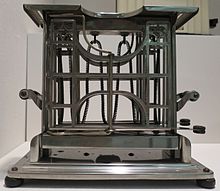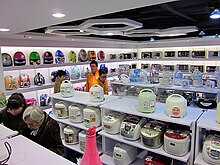Home appliance
| Home appliance | |
|---|---|
Kitchens and laundry rooms | |
| Wheels | In some cases |
| Examples | Refrigerator, toaster, kettle, microwave, blender |
A home appliance, also referred to as a domestic appliance, an electric appliance or a household appliance,[1] is a machine which assists in household functions[2] such as cooking, cleaning and food preservation.
Appliances are divided into three types: small appliances, major appliances (also known as white goods)[3] and consumer electronics (brown goods).[4]
Definition
Given a broad usage, the domestic application attached to home appliance is tied to the definition of
History

While many appliances have existed for centuries, the self-contained electric or gas powered appliances are a uniquely American innovation that emerged in the early twentieth century. The development of these appliances is tied to the disappearance of full-time
In America during the 1980s, the industry shipped $1.5 billion worth of goods each year and employed over 14,000 workers, with revenues doubling between 1982 and 1990 to $3.3 billion. Throughout this period, companies merged and acquired one another to reduce research and production costs and eliminate competitors, resulting in
The United States Department of Energy reviews compliance with the National Appliance Energy Conservation Act of 1987, which required manufacturers to reduce the energy consumption of the appliances by 25% every five years.[8]
In the 1990s, the appliance industry was very consolidated, with over 90% of the products being sold by just five companies. For example, in 1991, dishwasher manufacturing market share was split between
Major appliances

Major appliances, also known as white goods, comprise major household appliances and may include: air conditioners,
Small appliances

Small appliances are typically small household electrical machines, also very useful and easily carried and installed. Yet another category is used in the kitchen, including:
Product design
In the 1960s the
Consumer electronics
Consumer electronics or home electronics.
Life spans
A survey conducted in 2020 of more than thirteen thousand people in the UK revealed how long appliance owners had their appliances before needing to replace them due to a fault, deteriorating performance, or the age of the appliance.
| Appliance | Longest average estimated lifespan | Shortest average estimated lifespan |
|---|---|---|
| Washing machine | 21 years | 13 years |
| Tumble dryer | 24 years | 17 years |
| Dishwasher | 22 years | 13 years |
| Built-in oven | 29 years | 23 years |
| Fridge freezer | 24 years | 14 years |
| Fridge | 29 years | 18 years |
Home automation
There is a trend of networking home appliances together, and combining their controls and key functions.[18] For instance, energy distribution could be managed more evenly so that when a washing machine is on, an oven can go into a delayed start mode, or vice versa. Or, a washing machine and clothes dryer could share information about load characteristics (gentle/normal, light/full), and synchronize their finish times so the wet laundry does not have to wait before being put in the dryer.
Additionally, some manufacturers of home appliances are quickly beginning to place hardware that enables
Recycling

Appliance recycling consists of dismantling waste home appliances and scrapping their parts for reuse. The main types of appliances that are recycled are T.V.s, refrigerators, air conditioners, washing machines, and computers. It involves disassembly, removal of hazardous components and destruction of the equipment to recover materials, generally by shredding, sorting and grading.[23]
See also
Notes
References
- ^ "Household Appliance". Lexico Dictionaries | English. Archived from the original on 1 August 2020. Retrieved 25 April 2020.
- ^ "appliance (definition)". Merriam-Webster. Retrieved 4 May 2015.
- ^ "white goods". Collins English Dictionary. Retrieved 5 December 2014.
- ^ "brown goods". Collins English Dictionary. Retrieved 5 December 2014.
- ^ "Appliance". Merriam Webster. Retrieved 24 July 2013.
- ^ "Definition of household appliances". Collins Dictionary. Retrieved 24 July 2013.
- ^ a b c d e Bulletin, Manila (9 November 2014). "Tips to ensure safety of home appliances". Manila Bulletin. Archived from the original on 5 May 2015. Retrieved 5 May 2015.
- ^ a b c Encyclopedia of American Industries Volume 1. Gale Research. 1994.
- ]
- ^ a b c d e f "Efficient Appliances Save Energy -- and Money". Natural Resources Defense Council. Retrieved 4 May 2015.
- ^ "White Goods". www.icfdc.com. Data monitor, Static.scrib. Retrieved 6 May 2015.
- ^ a b "Best Small Appliances - Small Appliance Reviews". Consumer Reports. 29 May 2014. Retrieved 5 May 2015.
- ISBN 9781856693486.
- ^ "brown goods". Collins English Dictionary. Archived from the original on 8 December 2014. Retrieved 5 December 2014.
- ISBN 9781134361809. Archivedfrom the original on 18 April 2016. Retrieved 5 December 2014.
- ^ "Compact disc hits 25th birthday". BBC News. BBC. 17 August 2007. Retrieved 15 October 2019.
- ^ Pratt, Martin. "How long should you expect your large kitchen appliances to last?". Which?. Retrieved 27 June 2021.
- ^ a b Michelle, Bangert (1 September 2014). "Getting Smarter All the Time: The Appliance Landscape Continues to Evolve with the Rise of Internet-Connected Devices". Appliance Design. BNP Media. Archived from the original on 24 September 2015. Retrieved 5 May 2015.
- ^ Essers, Loek (10 December 2013). "Home appliance makers connect with open source 'Internet of things' project". Computerworld. Retrieved 5 May 2015.
- ^ Baguley, Richard; McDonald, Colin. "Appliance Science: The Internet of Toasters (and other things)". CNET. Retrieved 5 May 2015.
- ^ Hitchcox, Alan (February 2015). "The Internet of uncertainty". Hydraulics & Pneumatics. 68 (2): 8.
- ^ "Appliances of the Future Will Be Able to 'Talk' over Internet". The Mercury. 15 January 2015. Archived from the original on 24 September 2015. Retrieved 5 May 2015.
- S2CID 108437684.
Further reading
- Du, Z. (2012). "The Application Research of Small Home Appliance Product Based on Computer Aided Ergonomics". Proceedings of the 2012 International Conference of Modern Computer Science and Applications. Advances in Intelligent Systems and Computing. Springer. pp. 522–528. ISBN 978-3-642-33030-8.
- Kriske, Rob; Kriske, Mary (July/August 1984). "Home Appliance Repair". Mother Earth News. Accessed May 2015.
- "New computerized home appliance to assist with caring for the elderly". Rockdale Citizen. 8 April 2015. Retrieved 5 May 2015.
External links
- Home appliance at Curlie
